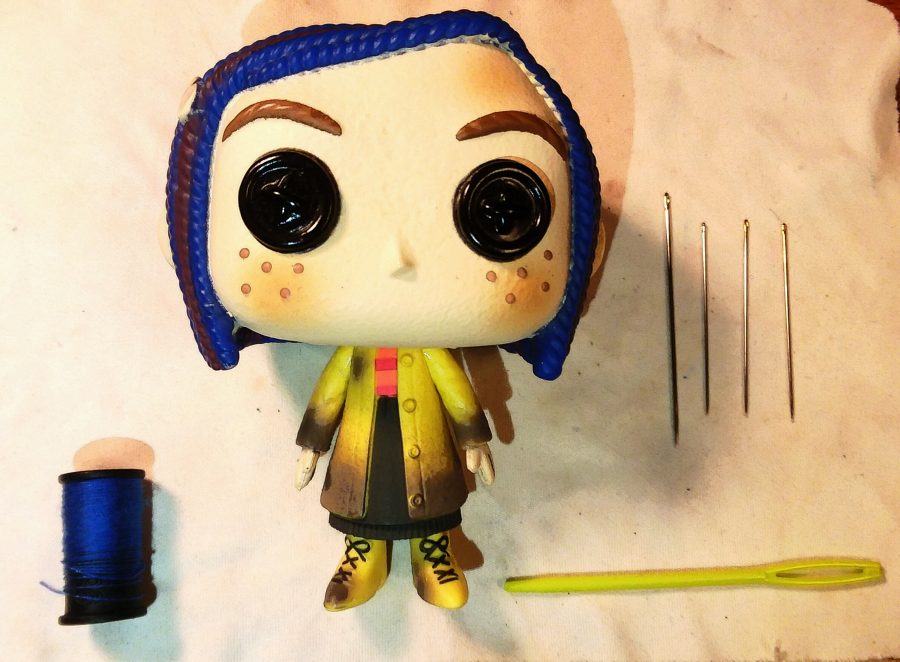Oh “Coraline”… looking back, you had to be my earliest gateway into horror.
As a kid, I was what you could call a certifiable weenie when it came to anything even horror adjacent. Haunted houses were an absolute no-go, I refused to watch horror movies, and I hardly had the courage to even peek into any of the “Scary Stories to Tell in the Dark” books. But for some reason when I was ten I was eager to see “Coraline” in theaters. So I did. And that same night I couldn’t get the horrifying image of the Other Mother out of my head. Shortly after I sought out the original Neil Gaiman novel and read it in one night, thinking that I would be toughened up by that point. Nope. Cue another night with little sleep and my head buried under the covers. But books aside, Henry Selick’s film adaptation of Coraline managed to both horrify and amaze kids everywhere, not just the scarediest of cats. And even now, eleven years later Coraline remains my favorite stop-motion films of all time (sorry not sorry Tim Burton) and a movie that only has more for the viewer to discover with each rewatch.
For those of you unfamiliar with the movie, Coraline is the story of 11-year-old Coraline Jones and her discovery of a mysterious door in her family’s new apartment that leads to an alternate Other World. Compared to her plain and ordinary life with busy parents who don’t have time for her, the Other World is full of magic and endless fun– including her Other Mother and Other Father. But things in this perfect world take a turn for the sinister as the Other Mother asks Coraline to stay forever with one catch: she has to sew buttons into her eyes. When Coraline refuses, she begins to see just how truly sinister the Other World is.
Now, to get down to business: The story itself is not only an entertaining and unique concept, but the film executes it well. While my nostalgia goggles could very well be clouding my view somewhat, compared to other children’s movies that seem very fast-paced when you revisit them years later, “Coraline” scarcely ever feels rushed. It knows how to capture quiet moments well like when Coraline explores the house for the first time or when she interacts with her weird but charming neighbors, and also how to pick up the pace when it needs to. I found in my most recent rewatch that the last half an hour of this film’s 100-minute runtime is extremely action-packed and moves along quickly in a way that it doesn’t seem too fast or hurried– storywise, this speed is earned as the stakes are at their highest and the true horrors of the Other World begin to unravel by the minute.
This may be a controversial opinion, especially with Halloween approaching, but I have always preferred “Coraline” over another one of the most iconic stop-motion films of the past 50 years- “The Nightmare Before Christmas.” In a way, this is partially ironic given that both films were directed by Henry Selick, and not Tim Burton like many believe, albeit the latter was his concept and has a certain aesthetic to it seen in his other stop-motion movies such as “Corpse Bride” and “Frankenweenie”. Story aside, I find that the animation and design of “Coraline” feels more immersive and more original than many of Tim Burton’s stop-motion films. The amount of detail put into “Coraline” is staggering- this is apparent from the very first scene that shows the Coraline doll being made. This is not to say that Burton’s films aren’t well crafted, but “Coraline” and the stop motion that comes out of Studio Laika is almost always breathtaking.
Following this, “Coraline” manages to both have bright and jarring fantastical imagery when needed in the film like in the Other World, but it also embraces the ordinary in many scenes that helps tether the story to reality- overcast days with snow-lined streets and mud, disgustingly slimy but realistic-looking food, small scenes that allow you to empathize with Coraline’s boredom as she pitters around the house. The film is also not afraid to use muted tones and colors- it doesn’t feel the need to keep its main audience hooked with bright and colorful visuals for its entire runtime- its story is enough to keep kids and adults alike invested in the story.
Another element that gives “Coraline” somewhat of a leg-up on “The Nightmare Before Christmas” in my book is the uniqueness of the character designs, at least when looking at the films from a wider perspective in regards to their creators. Looking at Studio Laika’s body of work, each of their stop-motion movies so far has had a cast of semi-realistic but stylistically different characters. As a result, each film has its own special flare. Of course, Tim Burton’s characters have a unique design in general compared to animation as a whole, but when comparing his films side-by-side, his characters arguably suffer from what older viewers of animation call “same face syndrome,” to the point where there are fan theories about three of his stop-motion protagonists being the same person solely because they are all tall, pale
Before rewatching “Coraline” for this review, I was uncertain if I would find anything new to talk about. There was scarcely anything I didn’t remember from the story, so I thought. As I rewatched “Coraline” I could not help but notice the sheer amount of foreshadowing this film has, both in its dialogue and its visuals. My gut reaction was something along the lines of “Oh these are supposed to make it easier for the kids in the audience to understand the movie” before realizing that all of these allusions would go over any first-time watcher’s head. Spoiling them would ruin the fun, but if you are like me and have seen this movie several times over, watch it again and try to see what new things you notice.
As the years pass and viewers who, like me, were fairly young when they first saw “Coraline” in theaters grow older, it seems as though the film is becoming more and more recognized as a classic. Good. While seeing any piece of media you’ve had fond memories of becoming popular again is a nice feeling, “Coraline” and Studio Laika deserve all of the praise people bestow upon them, even over a decade later. If you have yet to see “Coraline”, make sure to put it on your to-watch list. Its dark but fantastical story may make it a prime candidate for a Halloween-time viewing, but it is a pleasure to watch at any point in the year.
Photo Courtesy of Allison Musitano

























